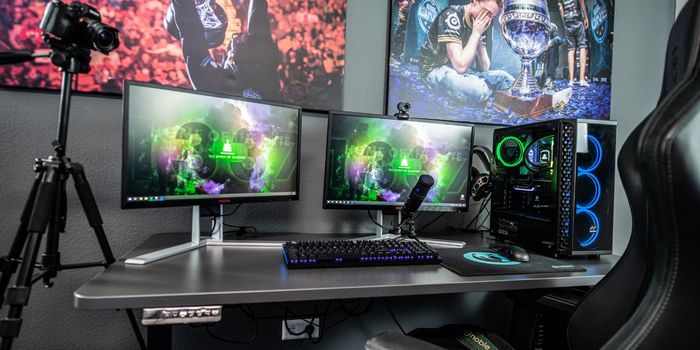Are you a die-hard gamer who spends countless hours playing the latest and greatest games on your PC? If so, you know how important it is to keep your computer running smoothly to avoid frustrating lag, crashes, and other issues. And to ensure that your computer stays in top shape during gaming sessions, monitoring its CPU temperature is one of the most important factors. It is challenging to know what temperature is considered “normal CPU temperature while gaming” because of many factors that affect the CPU’s temperature.
And that’s not all – we’ll cover causes, factors, ways, and CPU temperature ranges for maintaining your CPU temperature to ensure the smooth operation of your computer for optimal performance while gaming. If you’re ready to take your play to the next level and keep your computers running like well-oiled machines, let’s get started and learn about normal CPU temperature while gaming.
What’s Normal CPU Temperature While Gaming?
The normal CPU temperature while gaming can change depending on the specific CPU model and cooling solution in addition to ambient temperature.
- Generally, a CPU temperature of around 70°C to 80°C is considered normal when gaming, but this can be affected by various factors.
- The maximum heat a CPU can handle without sustaining damage changes based on the CPU model. Modern CPUs have around a 100°C-105°C maximum temperature threshold.
- The CPU’s running at its maximum temperature for an extended period may reduce its lifespan even if it does not cause immediate damage.
- If the CPU temperature is more than 80 degrees while gaming, it typically means there is an issue with your cooling solution. You may have to clean the CPU cooler and fans, reapply thermal paste, or upgrade to a better cooling solution such as an aftermarket air cooler or a liquid one.
The normal CPU temperature while gaming can differ, generally around 70°C to 80°C. It is essential to monitor the temperature consistently to stop it from surpassing the maximum threshold and damaging the CPU’s lifespan.
What are the Causes of High Temperatures?
Poor Airflow
Good airflow is essential to keep your CPU and other components cool. Fans typically provide airflow that draws in cool air and expels hot air. It’s important to ensure enough of them to create good airflow throughout your computer case. If your computer case has enough fans or is positioned correctly, heat may build up and cause high temperatures.
Dust Buildup
If your computer is not cleaned regularly, your fans and other cooling components may malfunction due to dust, and heat can build up. Dust can clog up fans and heatsinks, preventing them from working efficiently and causing heat to build up. Keeping your computer case and components regularly clean is important to remove accumulated dust.
Overclocking
Overclocking your CPU may trigger increased temperatures because it causes more heat than normal. Overclocking makes your processor run faster than its designed speed, which may make it unstable and build excessive heat. You should reduce the clock speed while overclocking in high temperatures or use a better cooling solution.
Inadequate Cooling
If you use an inadequate cooling system, such as the stock CPU cooler, you will likely face overheating issues while gaming. These cooling systems may be unable to manage the high temperature produced by intensive gaming and can lead to further heating up of components. It is better to replace your old cooling system with a sophisticated one.
Heavy Workloads
Heavy workloads put a lot of pressure on your CPU and can produce additional heat, increasing the temperature if you are running more than one program or game at a time. To stop high temperatures from heavy workloads, ensure your cooling system can manage the load and avoid performing too many operations simultaneously.
Understanding the causes of high temperatures can help you take preventive measures to keep your computer running smoothly. Try cleaning out your computer case, upgrading the cooling system, or reducing the CPU’s workload to achieve this goal.
Normal CPU Temperature Ranges While Gaming
When gaming, your CPU works hard to run the game and background processes, which may generate more heat than expected. However, a range of temperatures is considered normal for CPUs while gaming. These are the typical temperature ranges you can expect.
Idle Temperature
When your computer is inactive or not doing any task, the temperature of your CPU should be moderate, typically ranging from 30-40 degrees Celsius (86-104 degrees Fahrenheit). Since your CPU isn’t working hard and producing much heat, its temperature can remain tolerable.
Normal Gaming Temperature
The average core temperature of your CPU while gaming is likely higher than when it is idle, typically ranging from 50-70 degrees Celsius (122-158 Fahrenheit). Happens because your CPU works hard to run the game and other background processes, which results in more heat.
Maximum Safe Temperature
The maximum safe temperature for gaming is to stay below the maximum temperature that can damage your CPU. For most CPUs, this limit is 80-90 degrees Celsius (176-194 degrees Fahrenheit). If your CPU temperature is above this range, you should take steps to cool it down, like improving your cooling system or reducing your workload.
Remember that these temperature ranges vary greatly based on your CPU type and other factors, like the quality of your cooling system and the intensity of the game you are playing. These temperature ranges are generally considered safe and normal for most gaming CPUs.
List of Normal CPU Temperatures by CPU
| CPU Model | Normal Idle Temperature | Normal Gaming Temperature | Maximum Safe Temperature |
| Intel Core i3 | 30-40°C | 50-70°C | 80-90°C |
| Intel Core i5 | 30-40°C | 50-70°C | 80-90°C |
| Intel Core i7 | 30-40°C | 50-70°C | 80-90°C |
| Intel Core i9 | 30-40°C | 50-70°C | 80-90°C |
| AMD Ryzen 3 | 30-40°C | 50-70°C | 80-95°C |
| AMD Ryzen 5 | 30-40°C | 50-70°C | 80-95°C |
| AMD Ryzen 7 | 30-40°C | 50-70°C | 80-95°C |
| AMD Ryzen 9 | 30-40°C | 50-70°C | 80-95°C |
| Intel Core i3-10100 | 30-40°C | 50-70°C | 100°C |
| Intel Core i5-10600K | 30-40°C | 50-70°C | 100°C |
| Intel Core i7-11700K | 30-40°C | 50-70°C | 100°C |
| Intel Core i9-11900K | 30-40°C | 50-70°C | 100°C |
| AMD Ryzen 3 3200G | 30-40°C | 50-70°C | 95°C |
| AMD Ryzen 5 3600X | 30-40°C | 50-70°C | 95°C |
| AMD Ryzen 7 5800X | 30-40°C | 50-70°C | 95°C |
| AMD Ryzen 9 5950X | 30-40°C | 50-70°C | 95°C |
| Intel Core i3-8100 | 30-40°C | 50-70°C | 100°C |
| Intel Core i5-8400 | 30-40°C | 50-70°C | 100°C |
| Intel Core i7-8700K | 30-40°C | 50-70°C | 100°C |
Intel Processor Identification Utility (https://www.intel.com/content/www/us/en/support/articles/000005622/processors.html)
AMD Ryzen Master Utility (https://www.amd.com/en/technologies/ryzen-master)
Tom’s Hardware CPU Temperature Guide (https://www.tomshardware.com/reviews/cpu-temperature-guide,5663.html)
Factors that Affect CPU Temperature While Gaming
CPU model
The model of the CPU is one of the significant factors that affect its temperature while gaming. Different models have different heating requirements, so it’s important to know your CPU’s temperature range.
Cooling system
The cooling mechanism of your computer also disturbs the flow while you are gaming. Different types of cooling systems are available, including air, liquid, and heat pipe, each with advantages and disadvantages. A superior cooling system ensures a lower temperature in your CPU.
Intensity of the Gaming session
As your gaming session gets more intense, the CPU temperature rises. If you are playing a resource-intensive game with excessive graphics effects and processing, the CPU will have to labour harder and produce more heat, which leads to higher temperatures.
Ambient temperature
A hot ambient temperature in your room can affect the CPU efficiency of your computer’s cooling system and make it hard for your computer’s cooling system to keep the CPU cool.
Thermal paste
The thermal paste is the substance between the CPU and heatsink and transfers heat away from the CPU. The quality and application of the thermal past can greatly affect its performance, ultimately affecting the CPU temperature.
Background processes
When you are running other programs or applications in the background while gaming, it affects CPU temperature. These processes use CPU resources and generate additional heat.
Ways to reduce CPU temperature
The Central Processing Unit (CPU) is considered one of the essential components in a computer system. While working on intensive jobs like gaming or video rendering, the CPU might produce a lot of heat that can impact its performance and lifespan. Here are some tips to lower CPU temperature:
Over time, the CPU cooler and fans can accumulate dust and debris, affecting their efficiency. Cleaning them regularly using compressed air or a soft brush improves airflow resulting in reduced CPU temperature.
Reapply thermal paste
A critical component of thermal conductivity is the thermal paste used to transfer heat from the CPU to the cooler. It dries over time or becomes less effective, which can increase CPU temperature. Reapplying thermal paste improves its conductivity and reduces CPU temperature.
Install additional case fans
Adding more case fans can boost airflow and eliminate hot air to improve airflow and reduce CPU temperature. A positive airflow created by fans at the front of the case to draw in cool air and at the rear or top of the case to exhaust hot air is beneficial for reducing CPU temperature.
Upgrade the CPU cooler
The stock CPU cooler that comes with the CPU may need to be increased to handle high temperatures. Installing an aftermarket air cooler or a liquid cooler can significantly reduce CPU temperature and improve its performance.
Undervolt the CPU
Undervolting the CPU means reducing the voltage supplied, which will help lower power consumption and heat generation. However, you must be cautious since undervolting excessively may cause stability issues.
Adjust the fan curves
Fan curves control the speed at which fans spin. Manipulating fan curves to rotate fans faster at lower temperatures can decrease CPU temperature.
Lower the overclocking
While overclocking the CPU, you can increase its clock speed to a level higher than the manufacturer specified. Results in high heat generation which is managed by lowering the overclock frequency.
To maintain optimal performance and longevity of the CPU, keeping the CPU temperature low is essential. Cleaning the fans, removing dust from the cooler, reapplying thermal paste, adding additional case fans, upgrading to a better cooler and chipsets, adjusting fan curves, and lowering overclocking are effective methods for achieving this goal.
Conclusion
Monitoring its temperature while gaming is essential for maintaining optimal performance and protecting the CPU from malfunction. As we’ve discussed, the normal CPU temperature while gaming depends on various factors such as cooling solution, ambient temperature, and model. However, a range of approximately 70-80°C is considered standard for most CPUs when they are being used intensively. Monitoring the CPU temperature regularly and taking corrective measures to reduce it if it continues to rise beyond this normal span is crucial by monitoring the normal CPU temperature. At the same time, in gaming, you can protect your investment and maximize your gaming experience. Various software tools such as HWMonitor, CoreTemp, and SpeedFan allow you to monitor the CPU temperature in real-time and alarm you if it crosses a safe limit.
FAQS
What is the normal CPU temperature while gaming?
The normal CPU temperature while gaming varies widely depending on such factors as the model of the CPU, cooling solution, and ambient temperature. For most CPUs, a temperature range of approximately 70°C to 80°C is acceptable when gaming.
Is it safe for the CPU temperature to exceed the normal range while gaming?
Exceeding the normal range of the CPU may throttle down if its temperature exceeds the normal range, or it may even get damaged if it crosses the safe limit. Keeping your CPU within the normal range will help you avoid these issues while gaming.
How do I monitor the CPU temperature while gaming?
Various software tools such as HWMonitor, CoreTemp, and SpeedFan monitor CPU temperature in real-time and alert you if it crosses the safe limit. You can also use BIOS or UEFI settings to monitor the CPU temperature.
Is it necessary to monitor the CPU temperature while gaming?
Yes, measuring the CPU temperature while playing video games is crucial to ensure everything stays safe and sound and prevents harm to your computer. By frequently checking, you can also identify cooling or hardware issues before they wreak havoc.





